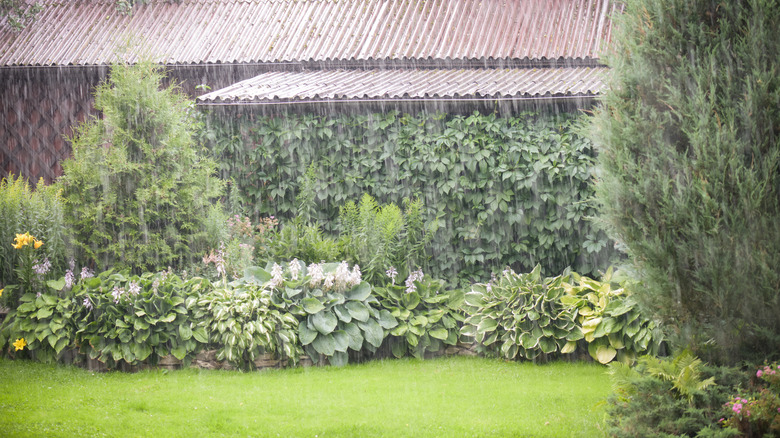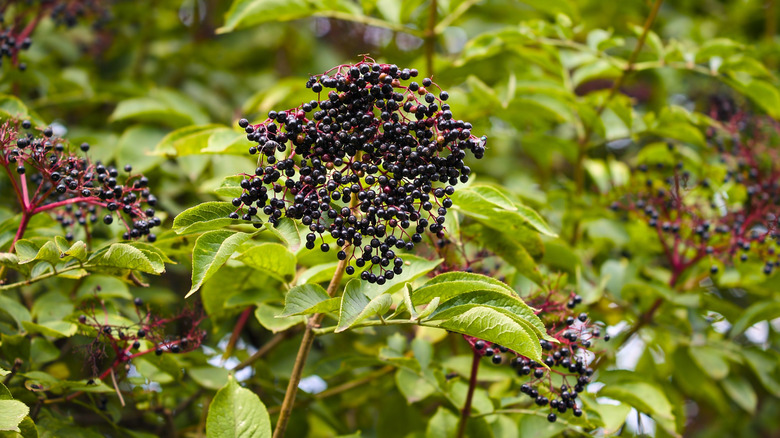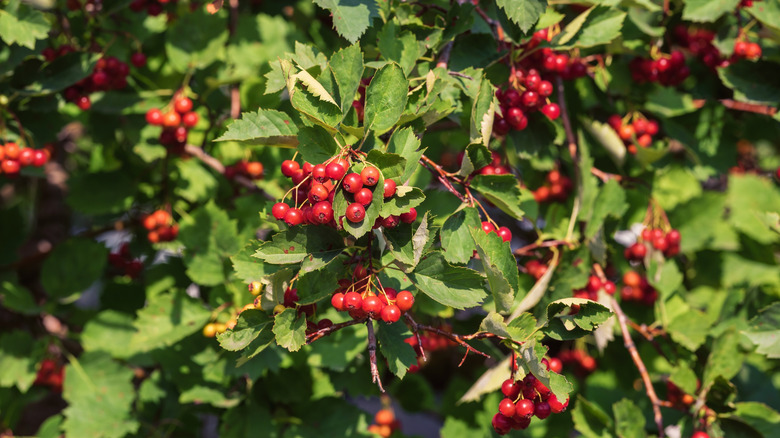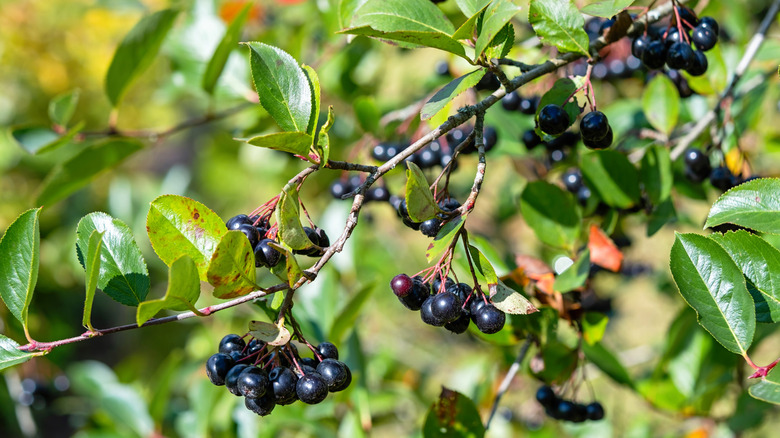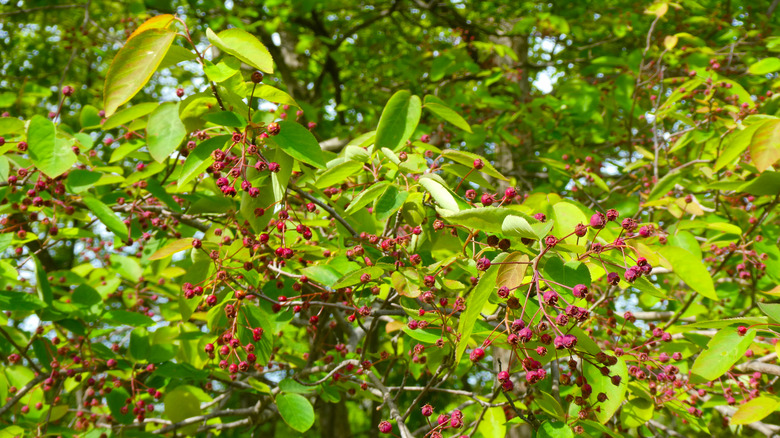8 Fruit Bearing Plants That Thrive In Wet Climates
When deciding which plants to bring into your yard, it is essential to consider the climate where you live. Certain plants thrive in a dry climate, while others prefer milder, wetter weather. If you want to grow fruit plants and live in a wet area, there are certain ones you should avoid. For example, peach and apple trees are more susceptible to disease and rot when the weather is constantly wet. Thankfully, there are some great fruit bearing plants that thrive in wet climates, such as the pawpaw tree and the cranberry bush.
However, when picking the best fruit plant to add to your garden, there are other considerations to be aware of apart from the weather. You need to ensure that the plant you pick suits your USDA Hardiness Zone, as some may not be winter hardy in your region. You should also have a think about the different locations in your garden and which plants would prefer certain areas. For example, if you have a spot in the full sun, a pear tree would fit in nicely. However, some options, such as the pawpaw tree, can grow in dappled shade if that is the only space available.
Pawpaw tree
The common pawpaw tree (Asimina triloba) is the largest edible fruit tree native to the U.S., reaching 15 to 30 feet in height. Although slow-growing, its intriguing purple blooms and rich, green leaves make it a worthwhile addition to a rainy garden. Suitable for zones 5 to 9, the pawpaw tree can tolerate wet or moist conditions. It grows in partial shade, but usually fruits best in the full sun. It typically starts to produce fruit after three or four years of growth, with clusters of green fruits appearing on the tree in late summer and early fall.
Pear tree
If pears are more of your thing, you're in luck! The common pear tree (Pyrus communis) is very tolerant of wet soil conditions. Suitable for growing in hardiness zones 4 to 8, this fruit tree does well in the full sun. There are various cultivars and varieties to pick from, depending on your location and the size of space you have available. Dwarf varieties are usually easier to harvest fruit from. They are also easier to maintain, which helps you avoid the common issues of pests and diseases that pear trees are more susceptible to.
American persimmon
Another fruit tree tolerant of wet sites, the American persimmon (Diospyros virginiana), can be grown in hardiness zones 4 to 9. It is suitable for both full sun and partial shade and can tolerate hot conditions, wind, and poor soils, making it a very adaptable addition to your garden! American persimmon will take a while to produce fruit after propagation or grafting, with some trees only reaching full production after 10 years of growth. This tree will flower in the spring and produce small, rounded fruit in the fall.
Elderberry
Elderberry shrubs (Sambucus canadensis) thrive in wet, well-drained locations and can be grown in both full sun and partial shade. Suitable for hardiness zones 3 to 9, elderberry shrubs can grow up to 12 feet in height and width and spread by root suckers to form thickets. This means that if you have one of these in your yard, it is essential to keep on top of the pruning. White flowers decorate the shrub in early summer, which then give way to the small, black fruit later on in the season.
Cranberry
Cranberry plants (Vaccinium macrocarpon) are native to wet bogs and swamps in North America, meaning that they thrive in damp conditions. This low-growing vine can be planted in hardiness zones 3 to 7 but needs a spot in the full sun. They prefer an acidic soil that is organically rich. Spreading up to 6 feet, cranberry vines double as good ground cover for suppressing weeds, keeping your garden healthy while producing crops. Small white-pink flowers appear on the vine in May and June, with the fruit maturing from August to November.
Mayhaw
If you have particularly waterlogged soils, the mayhaw tree (Crataegus opaca) may be perfect for you. The mayhaw tree is local to southern parts of the U.S., but not as common in other areas of the country. But given that it's suitable for hardiness zones 5 to 10, it could be a good fit for your garden. This tree is easy to grow and tolerates wind, partial shade, and soils heavy with moisture. Fragrant, white clusters of flowers appear in early spring, with the fruit ripening not long after in May, earning this tree its name.
Chokeberry
Both red chokeberry (Aronia arbutifolia) and black chokeberry (Aronia melanocarpa) are good options for growing in wet sites. However, red chokeberry is suitable for hardiness zones 4 to 9, whereas black chokeberry is hardy in zones 3 to 8. Both types have gorgeous white flowers with delicate pink anthers that bloom in May, making chokeberries not just a source of fruit, but also an ornamental garden addition in their own right. The fruits themselves appear in late summer and have tart, inedible fresh, but are often used in jams and jellies. Black chokberries taste a bit better than red and are used in juice and wine.
Downy serviceberry
Another fruit tree with stunning white flowers, the downy serviceberry (Amelanchier arborea) brightens your garden up with its showy blooms in spring and its dramatic fall foliage. Suitable for hardiness zones 4 to 9, this tree is pretty adaptable and can tolerate wetness, partial shade, and a range of soil conditions. It is not frost tender meaning it can handle the winter months. Its berries, which are not dissimilar to blueberries, ripen in late summer and fall. The downy serviceberry can reach upwards of 25 feet in height under the right conditions.
